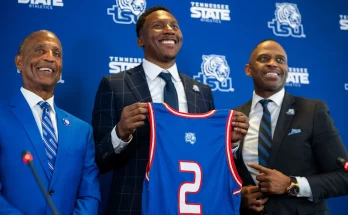From the moment Johnny Manziel stepped onto the field for the Texas A&M Aggies, it was clear that he was unlike anything college football had seen before. Electrifying, unpredictable, confident, and relentlessly competitive, Manziel didn’t just play the game—he redefined it. His flair for the dramatic, his uncanny ability to turn broken plays into highlight reels, and his charisma both on and off the field made him a household name before he ever took a snap in the NFL. Today, as his legacy continues to be discussed and celebrated, Manziel’s place among the elite in college football history has been firmly secured.
Known as “Johnny Football,” Manziel burst onto the national scene in 2012, when as a redshirt freshman, he led Texas A&M into the SEC and straight into the heart of the college football world. That season alone would’ve been enough to carve his name into the annals of history. He threw for over 3,700 yards and rushed for over 1,400 more, accounting for 47 total touchdowns and breaking records almost weekly. But it wasn’t just the stats—it was how he achieved them. He scrambled, improvised, and turned chaos into brilliance with a swagger that made fans roar and opponents wary.
Perhaps the most iconic moment of his 2012 campaign came on November 10, when Manziel and the Aggies marched into Tuscaloosa and stunned No. 1 Alabama. In a game few gave Texas A&M a shot to win, Manziel dominated Nick Saban’s vaunted defense, throwing for two touchdowns and running circles around one of the most disciplined units in the country. That game not only solidified his Heisman credentials but also changed the perception of what Texas A&M—and Manziel—could accomplish on a national scale. That same season, he became the first freshman ever to win the Heisman Trophy, one of the sport’s most sacred honors. His acceptance speech, humble and full of gratitude, stood in contrast to the fiery competitor fans had come to know on Saturdays. It marked a moment of recognition not just for his performance, but for the seismic shift he had initiated in college football.
Beyond the accolades, Manziel brought a level of entertainment to the sport that resonated far beyond College Station. He was must-see TV every weekend, and in an age of rapidly expanding digital media, his highlights dominated social platforms and sports coverage alike. Young fans saw a quarterback who wasn’t afraid to be himself, who took chances and often made magic out of nothing. He gave Texas A&M a new identity in the SEC and brought national relevance back to the program. Recruits noticed, fans rallied, and suddenly the Aggies were a perennial talking point—thanks in no small part to the kid in the No. 2 jersey.
After his historic Heisman season, expectations were sky-high in 2013. Manziel delivered again, throwing for over 4,100 yards and 37 touchdowns. Though the Aggies didn’t reach the same heights as the year before in the win-loss column, Manziel’s play remained top-tier. His duel against eventual national champion Auburn and his shootout with Ole Miss showcased his continued brilliance and leadership. Every time he took the field, there was a sense that something special might happen. He was a game-changer, a player who dictated the tempo, the narrative, and often the outcome.
Manziel’s impact extended beyond numbers and awards. He altered how the quarterback position was viewed. Before him, dual-threat quarterbacks often faced skepticism about their durability or long-term viability. But Johnny Football embraced the chaos, weaponized his agility, and showed that mobility and improvisation could be just as lethal as pocket poise and structure. Future stars like Kyler Murray, Baker Mayfield, and even Caleb Williams would follow a path that Manziel helped pave—quarterbacks who could move, think fast, and elevate their teams with sheer will.
Off the field, Manziel’s story has been a complex one. His post-college career was marked by turbulence, challenges, and a fair share of controversy. But even those struggles have played a part in his legacy. Through adversity, Manziel has remained in the public eye, never shying away from his past, owning up to mistakes, and continuing to seek growth. His openness about mental health, his desire to share his story, and his efforts to mentor younger athletes offer another dimension to his legacy—one rooted not just in performance, but in human experience.
To understand Johnny Manziel’s lasting influence on college football, one only needs to revisit the culture of the sport during his era. Stadiums were filled with fans who came to see what wild play he’d make next. Announcers struggled to keep up with the unpredictability he brought to every snap. Social media exploded with gifs and clips of his wild runs, improvised passes, and celebratory gestures. He became more than a player—he was a phenomenon.
In the years since he played his final down in college, the reverence for his achievements has only grown. Documentaries, interviews, and retrospectives routinely highlight his 2012 campaign as one of the greatest in college football history. Analysts debate where he ranks among the all-time greats, but one thing is clear: his name always comes up. And for good reason. He didn’t just play the game—he elevated it. He captivated a generation. He gave Texas A&M a historic chapter and gave fans memories that will last a lifetime.
In an age of NIL deals and player branding, Manziel was ahead of his time. His ability to connect with fans, generate headlines, and keep the spotlight on himself—sometimes for better or worse—was a blueprint for the modern college football star. Long before players could monetize their likeness, Manziel was showing the power of name recognition and star appeal. His No. 2 jersey became one of the most recognizable in the country, and his influence still lingers in how today’s athletes market themselves.
College football is built on moments, legends, and larger-than-life figures. Johnny Manziel fits all three. His time at Texas A&M was a whirlwind of excitement, brilliance, and unforgettable plays. While some may continue to debate where exactly he ranks among the sport’s legends, there’s no denying that his name belongs in the conversation. He inspired, entertained, and changed the game. He was chaos and poetry rolled into one, and for two glorious seasons, he was the heartbeat of college football.
Even now, fans across the country remember exactly where they were when Manziel juked a defender into the turf, or tossed a touchdown across his body on the run. They remember the celebration, the energy, the feeling that no lead was safe and no play was ever truly over. That’s the kind of legacy that statistics alone can’t quantify. That’s the kind of legacy reserved for the truly elite.
Johnny Manziel’s journey is one of triumph, turbulence, and transformation. But at its core, it’s a story of unforgettable greatness. He may not have had the longest career or the most pristine post-college résumé, but what he did during his time at Texas A&M left an indelible mark on the sport. He brought joy, excitement, and unpredictability to every Saturday, and in doing so, earned his rightful spot among college football royalty. For all the ups and downs, the highs and lows, the name Johnny Manziel will forever shine brightly in the story of college football—a star who burned fast, burned bright, and lit up the game like few ever have.



